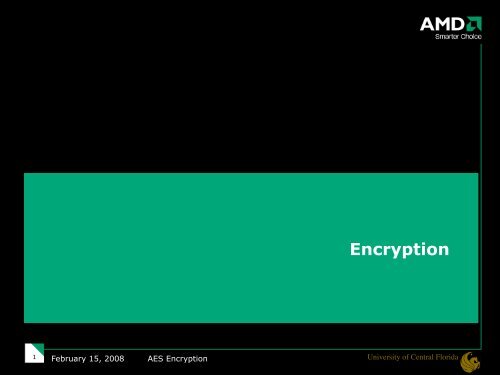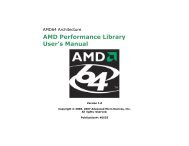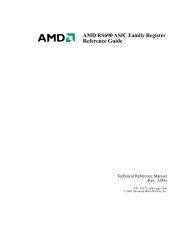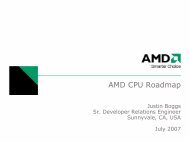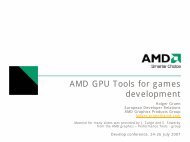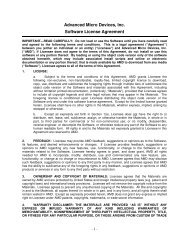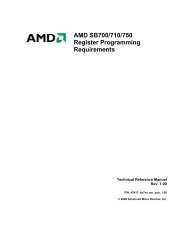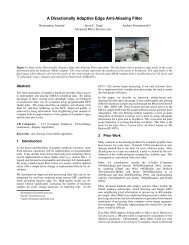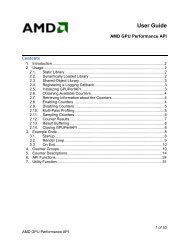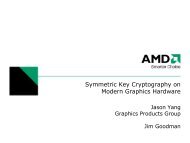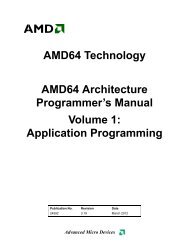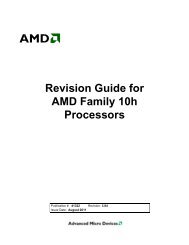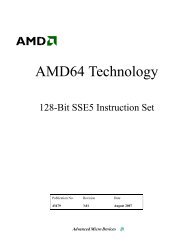AES Encryption ? University of Central Florida - AMD Developer ...
AES Encryption ? University of Central Florida - AMD Developer ...
AES Encryption ? University of Central Florida - AMD Developer ...
You also want an ePaper? Increase the reach of your titles
YUMPU automatically turns print PDFs into web optimized ePapers that Google loves.
1<br />
February 15, 2008<br />
<strong>AES</strong> <strong>Encryption</strong><br />
<strong>Encryption</strong><br />
<strong>University</strong> <strong>of</strong> <strong>Central</strong> <strong>Florida</strong>
<strong>Encryption</strong><br />
Goal: Optimization walkthrough using encryption as the<br />
example<br />
<strong>AES</strong> - Advanced <strong>Encryption</strong> Standard<br />
2<br />
February 15, 2008<br />
<strong>AES</strong> <strong>Encryption</strong><br />
<strong>University</strong> <strong>of</strong> <strong>Central</strong> <strong>Florida</strong>
<strong>AES</strong><br />
Works on 128 bits at a time in a 4x4 state array or 16 byte<br />
blocks<br />
3<br />
February 15, 2008<br />
<strong>AES</strong> <strong>Encryption</strong><br />
<strong>University</strong> <strong>of</strong> <strong>Central</strong> <strong>Florida</strong>
<strong>AES</strong> - Cipher Algorithm<br />
4<br />
February 15, 2008<br />
<strong>AES</strong> <strong>Encryption</strong><br />
<strong>University</strong> <strong>of</strong> <strong>Central</strong> <strong>Florida</strong>
Core Loop<br />
Steps:<br />
1) SubBytes<br />
2) ShiftRows<br />
3) MixColumns<br />
4) AddRoundKey<br />
5<br />
February 15, 2008<br />
<strong>AES</strong> <strong>Encryption</strong><br />
<strong>University</strong> <strong>of</strong> <strong>Central</strong> <strong>Florida</strong>
SubBytes<br />
SubBytes is a simple transformation applied to each byte<br />
6<br />
February 15, 2008<br />
<strong>AES</strong> <strong>Encryption</strong><br />
<strong>University</strong> <strong>of</strong> <strong>Central</strong> <strong>Florida</strong>
ShiftRows<br />
7<br />
February 15, 2008<br />
<strong>AES</strong> <strong>Encryption</strong><br />
<strong>University</strong> <strong>of</strong> <strong>Central</strong> <strong>Florida</strong>
MixColumns<br />
Finite field multiplies (binary polynomials)<br />
8<br />
February 15, 2008<br />
<strong>AES</strong> <strong>Encryption</strong><br />
<strong>University</strong> <strong>of</strong> <strong>Central</strong> <strong>Florida</strong>
AddRoundKey<br />
Add (XOR) the key to the state array<br />
9<br />
February 15, 2008<br />
<strong>AES</strong> <strong>Encryption</strong><br />
<strong>University</strong> <strong>of</strong> <strong>Central</strong> <strong>Florida</strong>
How do we implement this on the GPU?<br />
How do we represent the state array?<br />
10<br />
February 15, 2008<br />
<strong>AES</strong> <strong>Encryption</strong><br />
<strong>University</strong> <strong>of</strong> <strong>Central</strong> <strong>Florida</strong>
How do we implement this on the GPU?<br />
How do we represent the state array?<br />
Four registers - four components each<br />
r0.xyzw<br />
r1.xyzw<br />
r2.xyzw<br />
r3.xyzw<br />
10<br />
February 15, 2008<br />
<strong>AES</strong> <strong>Encryption</strong><br />
<strong>University</strong> <strong>of</strong> <strong>Central</strong> <strong>Florida</strong>
How to implement MixColumns?<br />
11<br />
February 15, 2008<br />
<strong>AES</strong> <strong>Encryption</strong><br />
<strong>University</strong> <strong>of</strong> <strong>Central</strong> <strong>Florida</strong>
How to implement MixColumns?<br />
What about now?<br />
11<br />
February 15, 2008<br />
<strong>AES</strong> <strong>Encryption</strong><br />
<strong>University</strong> <strong>of</strong> <strong>Central</strong> <strong>Florida</strong>
How to implement MixColumns?<br />
What about now?<br />
11<br />
February 15, 2008<br />
<strong>AES</strong> <strong>Encryption</strong><br />
<strong>University</strong> <strong>of</strong> <strong>Central</strong> <strong>Florida</strong>
Use lookup tables<br />
How big a table do we need?<br />
12<br />
February 15, 2008<br />
<strong>AES</strong> <strong>Encryption</strong><br />
<strong>University</strong> <strong>of</strong> <strong>Central</strong> <strong>Florida</strong>
Use lookup tables<br />
How big a table do we need?<br />
Bytes: 256 entries<br />
How many tables do we need?<br />
12<br />
February 15, 2008<br />
<strong>AES</strong> <strong>Encryption</strong><br />
<strong>University</strong> <strong>of</strong> <strong>Central</strong> <strong>Florida</strong>
Use lookup tables<br />
How How big big a a table table do do we we need?<br />
need?<br />
Bytes: 256 entries<br />
How many tables do we need?<br />
Swizzilng: arbitrary ordering (one table)<br />
Total: One table 256x4bytes<br />
12<br />
February 15, 2008<br />
<strong>AES</strong> <strong>Encryption</strong><br />
<strong>University</strong> <strong>of</strong> <strong>Central</strong> <strong>Florida</strong>
How to implement ShiftRows?<br />
13<br />
February 15, 2008<br />
<strong>AES</strong> <strong>Encryption</strong><br />
<strong>University</strong> <strong>of</strong> <strong>Central</strong> <strong>Florida</strong>
How to implement ShiftRows?<br />
Swizzling is free:<br />
r0’.xyzw = r0.xyzw<br />
r1’.xyzw = r1.wxyz<br />
r2’.xyzw = r2.zwxy<br />
r3’.xyzw = r3.yzwx<br />
13<br />
February 15, 2008<br />
<strong>AES</strong> <strong>Encryption</strong><br />
<strong>University</strong> <strong>of</strong> <strong>Central</strong> <strong>Florida</strong>
How to implement SubBytes?<br />
Lookup table again<br />
How big and how many tables?<br />
14<br />
February 15, 2008<br />
<strong>AES</strong> <strong>Encryption</strong><br />
<strong>University</strong> <strong>of</strong> <strong>Central</strong> <strong>Florida</strong>
SubBytes table?<br />
15<br />
February 15, 2008<br />
<strong>AES</strong> <strong>Encryption</strong><br />
<strong>University</strong> <strong>of</strong> <strong>Central</strong> <strong>Florida</strong>
SubBytes table?<br />
MixColumns table can be pre-computed with SubBytes<br />
transform. No SubBytes table is needed.<br />
15<br />
February 15, 2008<br />
<strong>AES</strong> <strong>Encryption</strong><br />
<strong>University</strong> <strong>of</strong> <strong>Central</strong> <strong>Florida</strong>
Putting it all together<br />
What about the XORs?<br />
R6XX or DX10 hardware supports native integer operations<br />
What about previous generations?<br />
16<br />
SubBytes +<br />
MixColumns<br />
February 15, 2008<br />
<strong>AES</strong> <strong>Encryption</strong><br />
float4 c0, r0;<br />
c0 = txMcol[r0.w].wzyx<br />
^ txMcol[r3.z].xwzy<br />
^ txMcol[r2.y].yxwz<br />
^ txMcol[r1.x].zyxw;<br />
r0 = c0 ^ tKeyadd[round_<strong>of</strong>fset]<br />
Shiftrows:<br />
component<br />
swizziling<br />
Add RoundKey:<br />
pre-computed<br />
round key lookup<br />
<strong>University</strong> <strong>of</strong> <strong>Central</strong> <strong>Florida</strong>
XOR on floating point hardware<br />
How do you do a XOR using only floating point hardware?<br />
17<br />
February 15, 2008<br />
<strong>AES</strong> <strong>Encryption</strong><br />
<strong>University</strong> <strong>of</strong> <strong>Central</strong> <strong>Florida</strong>
XOR on floating point hardware<br />
How do you do a XOR using only floating point hardware?<br />
17<br />
float4 XOR_CALC(float4 a, float4 b)<br />
{<br />
float4 ret;<br />
a*=256;<br />
b*=256;<br />
February 15, 2008<br />
float4 pa = frac(a/2.f)*2.f;<br />
float4 pb = frac(b/2.f)*2.f;<br />
ret = (pa==pb) ? 0 : 1;<br />
a -= pa;<br />
b -= pb;<br />
pa = frac(a/4.f)*4.f;<br />
pb = frac(b/4.f)*4.f;<br />
ret += (pa==pb) ? 0 : 2;<br />
a -= pa;<br />
b -= pb;<br />
pa = frac(a/8.f)*8.f;<br />
pb = frac(b/8.f)*8.f;<br />
ret += (pa==pb) ? 0 : 4;<br />
a -= pa;<br />
b -= pb;<br />
<strong>AES</strong> <strong>Encryption</strong><br />
}<br />
a -= pa;<br />
b -= pb;<br />
pa = frac(a/32.f)*32.f;<br />
pb = frac(b/32.f)*32.f;<br />
ret += (pa==pb) ? 0 : 16;<br />
a -= pa;<br />
b -= pb;<br />
pa = frac(a/64.f)*64.f;<br />
pb = frac(b/64.f)*64.f;<br />
ret += (pa==pb) ? 0 : 32;<br />
a -= pa;<br />
b -= pb;<br />
pa = frac(a/128.f)*128.f;<br />
pb = frac(b/128.f)*128.f;<br />
ret += (pa==pb) ? 0 : 64;<br />
a -= pa;<br />
b -= pb;<br />
pa = a;<br />
pb = b;<br />
ret += (pa==pb) ? 0 : 128;<br />
return ret/255;<br />
<strong>University</strong> <strong>of</strong> <strong>Central</strong> <strong>Florida</strong>
Using XOR tables<br />
18<br />
float4 c0, r0;<br />
c0 = txMcol[r0.w].wzyx<br />
^ txMcol[r3.z].xwzy<br />
^ txMcol[r2.y].yxwz<br />
^ txMcol[r1.x].zyxw;<br />
float4 a0,a1,b0,b1,c0,t0,t1;<br />
a0 = txMcol[r0.w].wzyx;<br />
a1 = txMcol[r3.z].xwzy;<br />
t0 = XOR(a0, a1);<br />
b0 = txMcol[r2.y].yxwz;<br />
b1 = txMcol[r1.x].zyxw;<br />
t1 = XOR(a, b);<br />
c0 = XOR(t0, t1);<br />
February 15, 2008<br />
<strong>AES</strong> <strong>Encryption</strong><br />
float4 XOR(a,b)<br />
{<br />
float4 out;<br />
out.x = Txor[a.x][b.x];<br />
out.y = Txor[a.y][b.y];<br />
out.z = Txor[a.z][b.z];<br />
out.w = Txor[a.w][b.w];<br />
return out;<br />
}<br />
<strong>University</strong> <strong>of</strong> <strong>Central</strong> <strong>Florida</strong>
Using XOR tables<br />
18<br />
float4 c0, r0;<br />
c0 = txMcol[r0.w].wzyx<br />
^ txMcol[r3.z].xwzy<br />
^ txMcol[r2.y].yxwz<br />
^ txMcol[r1.x].zyxw;<br />
float4 a0,a1,b0,b1,c0,t0,t1;<br />
a0 = txMcol[r0.w].wzyx;<br />
a1 = txMcol[r3.z].xwzy;<br />
t0 = XOR(a0, a1);<br />
b0 = txMcol[r2.y].yxwz;<br />
b1 = txMcol[r1.x].zyxw;<br />
t1 = XOR(a, b);<br />
c0 = XOR(t0, t1);<br />
February 15, 2008<br />
<strong>AES</strong> <strong>Encryption</strong><br />
float4 XOR(a,b)<br />
{<br />
float4 out;<br />
out.x = Txor[a.x][b.x];<br />
out.y = Txor[a.y][b.y];<br />
out.z = Txor[a.z][b.z];<br />
out.w = Txor[a.w][b.w];<br />
return out;<br />
}<br />
float4 a, b, c0, r0;<br />
a = txMcol[r0.w][r3.z];<br />
b = txMcol[r2.y][r1.x];<br />
c0 = XOR(a, b);<br />
<strong>University</strong> <strong>of</strong> <strong>Central</strong> <strong>Florida</strong>
Analyzing the performance<br />
Whether using ALU or textures what are the performance<br />
implications?<br />
19<br />
February 15, 2008<br />
<strong>AES</strong> <strong>Encryption</strong><br />
<strong>University</strong> <strong>of</strong> <strong>Central</strong> <strong>Florida</strong>
Analyzing the performance<br />
Whether using ALU or textures what are the performance<br />
implications?<br />
ALU:TEX ratio<br />
# fetch instructions<br />
Memory access patterns<br />
Texture sizes<br />
XOR tables achieves rates <strong>of</strong> ~300 Mbps<br />
Can we go faster?<br />
19<br />
February 15, 2008<br />
<strong>AES</strong> <strong>Encryption</strong><br />
<strong>University</strong> <strong>of</strong> <strong>Central</strong> <strong>Florida</strong>
Latency hiding<br />
20<br />
February 15, 2008<br />
<strong>AES</strong> <strong>Encryption</strong><br />
<strong>University</strong> <strong>of</strong> <strong>Central</strong> <strong>Florida</strong>
Latency hiding<br />
Use ALU instructions to hide memory fetch latency<br />
Solution:<br />
Use both ALU and fetches for XOR calculations<br />
Mixed instructions reach ~990 Mbps<br />
20<br />
February 15, 2008<br />
<strong>AES</strong> <strong>Encryption</strong><br />
<strong>University</strong> <strong>of</strong> <strong>Central</strong> <strong>Florida</strong>
What about with native XOR hardware?<br />
Native XOR reaches performance <strong>of</strong> ~3.5 Gbps<br />
What are the performance issues?<br />
21<br />
…<br />
int4 c0, c1, c2, c3;<br />
for(int i=0; i
Can we do better?<br />
22<br />
February 15, 2008<br />
<strong>AES</strong> <strong>Encryption</strong><br />
<strong>University</strong> <strong>of</strong> <strong>Central</strong> <strong>Florida</strong>
Can we do better?<br />
Bitslicing - treat the processor as a vector processor with<br />
each bit representing an ALU unit (i.e. a 32-bit processor is<br />
a virtualized 32 vector processor)<br />
Everything in <strong>AES</strong> is be computed using AND, OR, NOT, and<br />
XOR gates<br />
Using bitslicing, GPU achieves 18.5 Gbps<br />
22<br />
February 15, 2008<br />
<strong>AES</strong> <strong>Encryption</strong><br />
<strong>University</strong> <strong>of</strong> <strong>Central</strong> <strong>Florida</strong>


